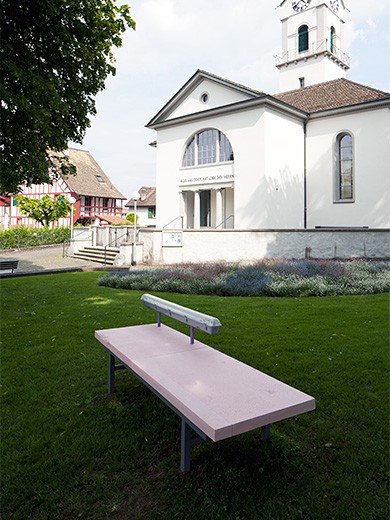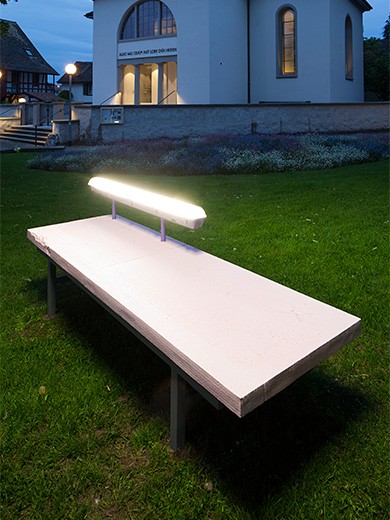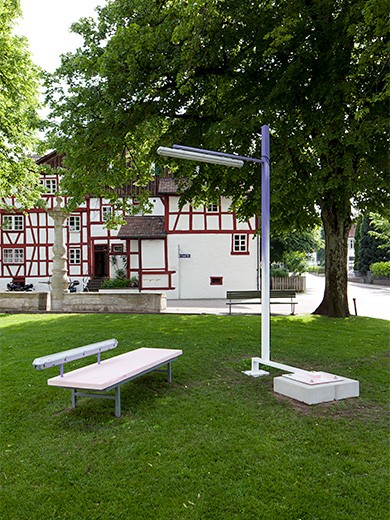Cristian Andersen
Sundaymorning: Daybed, 2015

Die skulpturalen Werke des in Zürich lebenden dänischen Künstlers Cristian Andersen (*1974) befassen sich mit den klassischen Fragestellungen der Skulptur: dem Spiel mit Volumen und Leere, An- und Abwesenheit, Vorder- und Hintergrund, Schwere und Leichtigkeit. Die überraschenden Oberflächen seiner aufwendig produzierten und oftmals auffallend grossen Keramiken, deren geometrische Abstraktionen teilweise an die klassische Moderne mit Ansätzen der Kunst der 1950er Jahre erinnern, zeugen von einem überaus gekonnten Umgang mit Material und Form.
Andersen baut seine Skulpturen in mehreren Etappen aus Objets trouvés zusammen. Figürlich-narrative Elemente treffen auf konstruktiv-abstrakte, postminimale Formen und industrielle Werkstoffe wie Sagex-Hartschaum oder, so im Fall von Sundaymorning, auf Schaumstoff. Diese Versatzstücke montiert der Künstler neu zusammen, indem er ihre räumliche Qualität plastisch auslotet: vorne, hinten, oben unten. In einem zweiten Schritt fertigt Andersen von diesen Plastiken Silikon-Negative an, die in einem komplexen Arbeitsprozess eingerüstet, ummantelt und mittels einer partiell eingefärbten, enorm dichten und selbsthärtenden Industriekeramik abgegossen werden. Die Kopien, die so entstehen, sind nun das Original – und haben zugleich einen Mimikry-Effekt, wenn die porzellanhafte Keramik genau so aussieht wie der ursprünglich verwendete Schaumstoff. Mit Ironie und verspieltem Humor wechselt das Pasticcio der ursprünglichen Plastik in eine neue materielle Einheit.
Andersens Humor ist auch immer in den Titeln seiner Arbeiten zu erkennen: Sundaymorning weist einerseits auf den Standort des Werks in der Nähe einer Kirche hin, andererseits aber auch auf den gleichnamigen Song von Velvet Underground. Gleichzeitig spielt der Künstler mit dem Bonmot «die Kirche im Dorf lassen», wobei hier die Stadt langsam ins Dorf vordringt oder, mit AAA, dort schon angekommen ist. Die Liege als Sinnbild der Urbanisierung, deren formale Eigenschaften wie auch ihre Anknüpfung an die bedeutende Rolle des dänischen Designs im 20. Jahrhundert und die situationsbedingten Gegensätzlichkeiten sind wiederkehrende Elemente im Œuvre des Künstlers. Das Möbel als privater Gegenstand, der hier entfremdet im öffentlichen Raum steht, lädt zum Tagträumen ein – auch im Dunkeln, wenn das Daybed mit integrierter FL-Leuchte die Nacht zum Tag werden lässt. Georgina Casparis
Courtesy the artist und Galerie Bob van Orsouw, Zürich
English Version
The sculptural works of Zurich-based Danish artist Cristian Andersen (b. 1974) address the traditional issues pertaining to sculpture: playing with volume and void, presence and absence, foreground and background, heaviness and lightness. The surprising surfaces of his laboriously produced and often noticeably large ceramics, with their geometric abstractions that are sometimes reminiscent of classical modernism with hints of 1950s art, bear witness to extremely adept handling of material and form.
Andersen assembles his sculptures in several stages, from found objects. Figurative narrative elements meet constructivist abstract post-minimalist forms and industrial materials, such as Sagex rigid foam or, as in the case of Sundaymorning, other foam material. The artist puts these components together in new ways by sculpturally exploring their spatial qualities: from front to back and top to bottom. In a second step, Andersen uses these sculptures to make silicone negatives which, in a complex working process, are surrounded by scaffolding, encased, and cast in partially pigmented, enormously dense, self-curing industrial ceramic material. The copies that emerge from this process are now the originals – and at the same time, they generate an effect of mimicry, as the porcelain-like ceramics look exactly the same as the foam material that was used initially. With irony and playful humour, the pastiche of the initial sculpture changes into a new material unit.
Andersen’s humour is also always evident in the titles of his works: on the one hand, Sundaymorning refers to the work’s location in the vicinity of a church, but also, on the other hand, to the similarly named Velvet Underground song. At the same time, the artist plays with the saying “die Kirche bleibt im Dorf” (literally: “the church remains in the village”, meaning “there is no need to get carried away”), whereby the city is slowly advancing into the village here or, with AAA, has already arrived in the village. As a symbol of urbanisation, the daybed, its formal properties and its association with the significant role of Danish design in the 20th century, along with situation-specific contrasts, are recurring elements in this artist’s oeuvre. This piece of furniture, as a private object, estranged here in the public space, invites daydreaming – even in the dark, when the daybed’s integrated fluorescent lamp turns night into day. Georgina Casparis
Courtesy of the artist and Galerie Bob van Orsouw, Zurich


